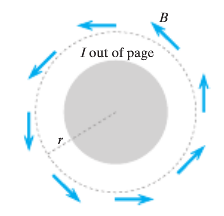Magnetic Field of a Long Thick Wire Using Ampere's Law: Difference between revisions
No edit summary |
No edit summary |
||
| Line 14: | Line 14: | ||
[[File:Wire.png]] | [[File:Wire.png]] | ||
To find the magnetic field at a distance r from the center of the long wire apply Ampere's Law. | To find the magnetic field <math>B</math> at a distance <math>r</math> from the center of the long wire apply Ampere's Law. By the symmetry of the wire <math>B</math> will always be constant and tangential to the circular path at every point around the wire. | ||
d<math>{\vec{l}}</math> | |||
The path integral <math>{{\oint}d\vec{l}}</math> in this situation is equal to the circumference of the circular path around the wire. This is equal to <math>2πr</math>. | |||
Using the formula above and plugging in <math>{d\vec{l}}</math> we have: <math>{B(2πr) = μ_0I}</math>. To solve for <math>B</math> divide both sides by <math>2πr</math>. | |||
This results in the equation: <math>{B = \frac{μ_0I}{2πr}}</math> which is equal to <math>{\frac{μ_02I}{4πr}}</math>. This is the equation for the magnetic field of a long thick wire that is found using the Biot-Savart law. | |||
==Connectedness== | ==Connectedness== | ||
Revision as of 22:24, 1 December 2015
claimed by Baron Hall
The Main Idea
This section explains how to find the magnetic field near a long thick wire using Ampere's Law. Finding the magnetic field using Ampere's Law is very simple compared to finding it using the Biot-Savart law.
Formula for Ampere's Law
How to Find Magnetic Field of A Long Thick Wire
To find the magnetic field [math]\displaystyle{ B }[/math] at a distance [math]\displaystyle{ r }[/math] from the center of the long wire apply Ampere's Law. By the symmetry of the wire [math]\displaystyle{ B }[/math] will always be constant and tangential to the circular path at every point around the wire.
The path integral [math]\displaystyle{ {{\oint}d\vec{l}} }[/math] in this situation is equal to the circumference of the circular path around the wire. This is equal to [math]\displaystyle{ 2πr }[/math].
Using the formula above and plugging in [math]\displaystyle{ {d\vec{l}} }[/math] we have: [math]\displaystyle{ {B(2πr) = μ_0I} }[/math]. To solve for [math]\displaystyle{ B }[/math] divide both sides by [math]\displaystyle{ 2πr }[/math].
This results in the equation: [math]\displaystyle{ {B = \frac{μ_0I}{2πr}} }[/math] which is equal to [math]\displaystyle{ {\frac{μ_02I}{4πr}} }[/math]. This is the equation for the magnetic field of a long thick wire that is found using the Biot-Savart law.
Connectedness
- How is this topic connected to something that you are interested in?
- How is it connected to your major?
- Is there an interesting industrial application?
History
Put this idea in historical context. Give the reader the Who, What, When, Where, and Why.
See also
Are there related topics or categories in this wiki resource for the curious reader to explore? How does this topic fit into that context?
Further reading
Books, Articles or other print media on this topic
External links
Internet resources on this topic
References
This section contains the the references you used while writing this page

